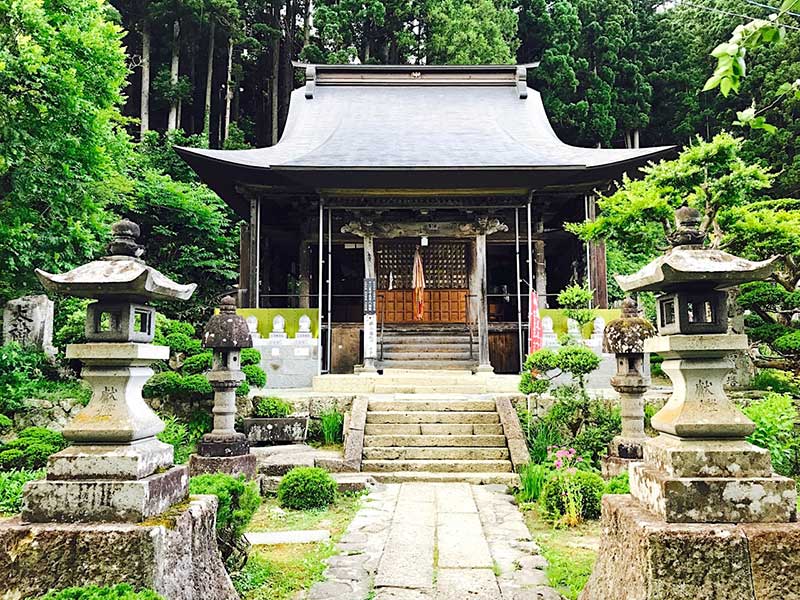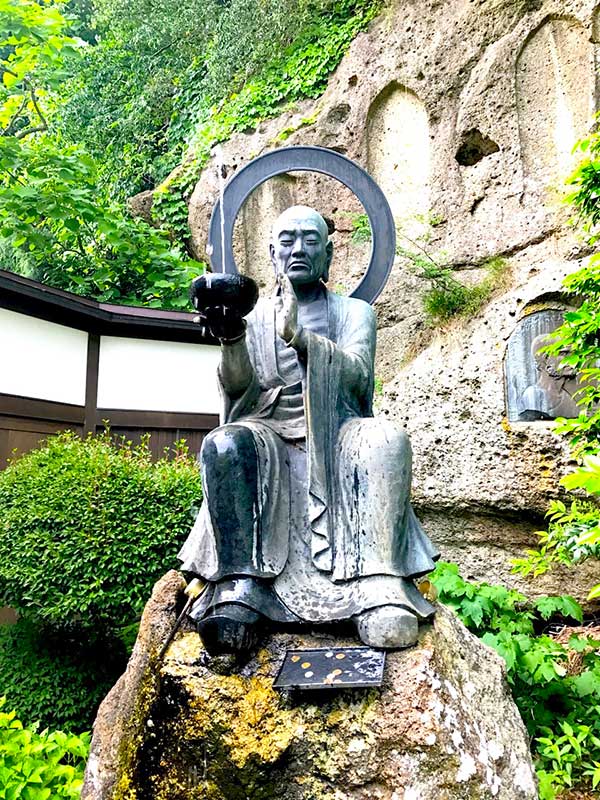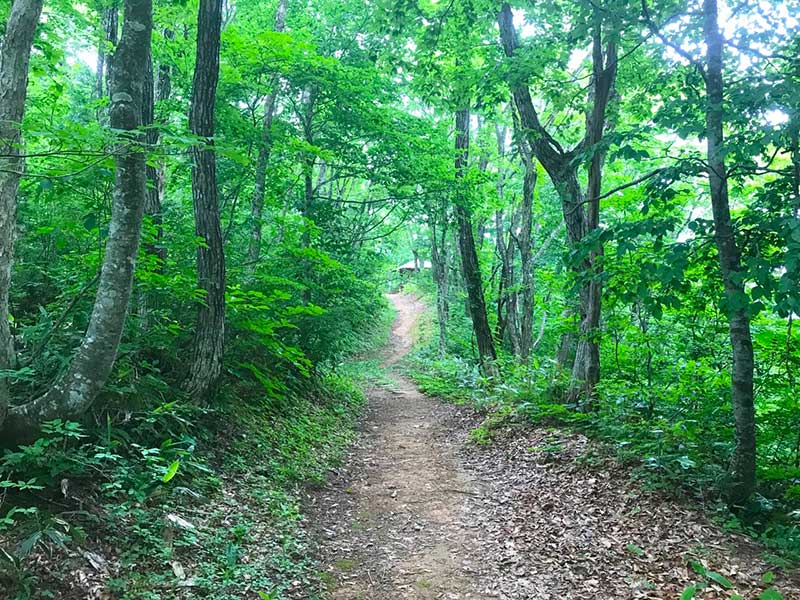A self-guided walking tour following in the footsteps of famed wandering poet Basho on his journey along the Narrow Road to the Deep North.
Self-guided walking tour visiting sites Basho exquisitely and sparingly illustrates in his haiku poetry. Follow trails trodden by the poet in Japan’s deep north Tohoku region, from the coast to forests in remote countryside; accommodation in onsen thermal hot spring hotels and inns, with plentiful local cuisine.
May - July & September - November.
The Basho Wayfarer is a 6-day, 5-night tour starting in Sendai and finishing at Yamadera. Tour accommodation is in Japanese inns and hotels. Please read more on accommodation here. For more information please contact us.
This self-guided walking tour follows in the footsteps of the famed wandering haiku poet Matsuo Basho, who described his journey in his classic poetic travelogue Oku-no-hosomichi, or Narrow Road to the Deep North. Basho famously wrote ‘Seek not to follow in the footsteps of wise men of old, but seek what they sought’ and this tour provides an authentic experience of Japan and, perhaps, some opportunities for self-discovery. It is certainly an entertaining way to discover Japan’s northern Tohoku region, its distinctive culture and friendly people.
Although Basho made his journey more than 300 years ago the locals, hardy characters who have learned to survive the region’s harsh winters, seem never to have forgotten his visit. Warm and friendly greetings are often accompanied with recitations of the great bard’s concise and eloquent poetry. They are also proud of their plentiful soothing and therapeutic onsen hot spring baths, sumptuous local cuisine and top-class sake. Combined with comfortable accommodation, these provide the perfect foil to each day’s walking and perhaps the stimuli to help find one’s own muse.
The Basho Wayfarer tour begins in Sendai, which was once the stronghold of the Date Clan. This was a powerful samurai family, which, although antithetical to the ruling shogun, was able to dominate the Sendai region for over three hundred years. To this day, their home city remains the largest in the north of Japan. From here your journey takes you via the site of a ruined fortress at Tagajo to Matsushima Bay, the beauty of which left Basho at a loss for words. Temples follow, including Entsuin, Zuiganji and Chusonji, the exquisiteness of which may well take your breath away.
The tour passes through beautiful forests, their foliage new with the crisp, myriad shades of greens in spring; opulently verdant in summer; and in autumn vividly rich with the season’s multiple colours. En route in one of these forests stands Hojin-no-Ie, an atmospheric thatched building that is treasured as the only remaining structure where Basho is known to have stayed. The poet vividly describes in his forté haiku an overnight visit as less than pleasant. However, you may enjoy a refreshing cup of green tea reliving Basho’s misadventure here before transferring to your comfortable accommodation replete with riverside onsen baths and delicious evening meal of locally-sourced ingredients.
The walking is generally comfortable but does include some steeper sections, including the remote Natagiri-toge pass. Basho feared for his life on this pass but these days it is much more fearful in reputation than actuality and can be negotiated relatively quickly. Yamadera is the final temple of the tour but definitely one not to be missed. A climb along a path through massive cedar trees is required to reach this sacred site, one of the most spectacularly located of any in Japan. But the effort needed to reach the top is repaid with lovely views afforded across the countryside below. In the summer season Basho’s famous cicada haiku, celebrating Yamadera, will literally be ringing in your ears.
Accommodation is mostly in Japanese-style hotels and family-run inns, some with distinctive and traditional Japanese surroundings including paper sliding shoji doors and straw tatami mat flooring. Onsen hot springs, which feature on each day of this tour, are an excellent way to wake up in the morning and relax after walking in the evening. Your hosts provide a warm welcome and feasts of home-cooked, local cuisine that appeals both to the eye and the palate.
A Level 2 tour, the distance walked on Basho Wayfarer tour is comfortable at no more than 14km (8.5 miles) each day. The route includes undulating forest terrain and some steeper sections. However, all can be taken at a leisurely pace allowing full enjoyment of the beautiful surroundings as well as Basho’s poetry. The materials provided, including the route booklet, fully complement this tour and are based on Walk Japan's extensive research of the Tohoku area and its expertise derived from over 25 years of leading guided walking tours throughout Japan.
The Basho Wayfarer includes easy-to-follow, detailed instructions. Daily walking distances are between 5 - 14km (3.1 - 8.7 miles) and elevation gain averages between 100 - 400m (328 - 1,312ft). Options may be provided to lengthen or shorten each day’s itinerary to suit your energy levels. There are some ascents on well-maintained forest trail and also steep stone steps. Care needs to be taken throughout this tour especially when it is wet underfoot. Your main luggage is transferred between each accommodation including one overnight courier transfer. Also included in the tour are: a JR East-South Hokkaido Rail Pass for rail transport during the tour; and three transfers by private vehicle to the start and from the end of more remote walking trails.
What is included?
A Pre-tour Pack. The pack includes details on how to prepare for your Wayfarer Tour, how to travel from your arrival point in Japan to the accommodation at the start of your tour, weather advice, checklist, etc. The pack also includes details on exploring sites related to Basho in Tokyo, if you so wish, before making your train journey north to the start of the tour. Upon receipt of a completed manifest form, your pre-tour pack will be made available for online viewing approximately two months prior to the start date of your tour. It can also be downloaded as a PDF file for offline use.
A Wayfarer Route Booklet. This is provided on arrival at your first night’s accommodation, and is an easily portable booklet. This includes detailed walking directions and logistical information, including maps, photographs and site-specific information such as lunch/cafe recommendations, museum/gallery recommendations and historical points of interest. A rain-resistant pouch and shoulder strap are also provided for ease of carrying the booklet while walking.
Click here for a sample of the Wayfarer booklet.
5-nights’ accommodation, 5 breakfasts, and 4 dinners.
Main baggage transfer between accommodation, including two overnight.
JR East-South Hokkaido Rail Pass for rail transport during the tour.
Three private vehicle transfers.
In-country (Japan), 24-hour English-language emergency support.
What is not included?
Not included are flights, lunches and drinks with meals, one dinner and transfers other than those noted in the itinerary.
Please note that Wayfarer self-guided tours sometimes require transfers by public buses and/or trains that are not included in the tour price. This is either because it is not possible to reserve them in advance or to allow maximum flexibility for tour participants. Please contact us for further details.

Please note that on the morning of Day 3, your main baggage will be shipped in advance overnight to your accommodation on Day 4. On this day, you will need to carry all items you require overnight and your daypack should be sufficiently large to accommodate these items.
Day 1 Sendai
Your tour itinerary starts upon check-in at your accommodation in Sendai, which is approximately two hours by shinkansen bullet train from Tokyo. The Wayfarer Route Booklet will be awaiting your arrival at the tour hotel. Check-in is at 3pm.
Accommodation: Western-style hotel.
Meals: N/A.
Total walking: N/A.
Total elevation gain: N/A.
Day 2 Sendai – Matsushima
Transfer by train in the morning to Tagajo, which takes its name from the castle that once stood here marking the border of Japan’s northern frontier in the eighth century. A visit to the excellent Tohoku History Museum is followed by a leisurely walk through the impressive castle remains before strolling to Shiogama Port. On the way, an optional climb up a flight of 202 stone steps to Shiogama Jinja is well worth the effort as this shrine is designated an ichinomiya, the highest rank in the Shinto tradition.
Basho explored Matsushima Bay with its iconic pine-laden islands in a fishing boat. You, however, follow his journey here aboard a modern sightseeing boat from the local port. For centuries known amongst the Japanese as one of their nation’s Three Scenic Views, Basho was so overcome by emotion at the scenery that he found himself at a loss for words and never penned a poem to the bay’s beauty.
Your hotel and a short walking trail around Fukuura-jima, a scenic island, are within easy walking distance of the boat terminal. Onsen thermal hot spring baths in your hotel provide a delightful way to relax and refresh yourself before enjoying an impressive dinner of local cuisine.
Accommodation: Japanese-style hotel with onsen hot spring baths.
Meals: Breakfast & dinner provided.
Total walking: 7-10km (4-6miles).
Total elevation gain: 150m (500ft).
Day 3 Matsushima – Hiraizumi
Your luggage is sent ahead by overnight courier service, before you set out to explore Entsu-in temple, famous for its beautiful gardens, and Zuigan-ji, an outstanding example of classical Japanese temple architecture. Often likened to both Nijo-jo castle in Kyoto and the religious centre at Koyasan, the temple and its precincts impart both the authority of the ruling feudal Date Clan and the quietude of the monks that once lived and trained in the surrounding caves here.
A short walk brings you to Matsushima Station for onward travel to Hiraizumi, a UNESCO World Heritage site, where a serene forest walk up to the vast temple complex of Chuson-ji culminates in a visit to the Konjiki-do, a small structure almost entirely covered in gold leaf and intricate decoration. This is the final resting place of the Northern Fujiwara Clan, whose story is one of tragedy and pathos in the twelfth century. Inspired, Basho composed his reflection on impermanence here:
Summer grass,
All that remains of a warrior’s dreams.
Your Japanese-style accommodation is within easy walking distance and has the attractions of onsen baths and another great evening meal.
Accommodation: Japanese-style hotel with onsen hot spring baths.
Meals: Breakfast & dinner provided.
Total walking: 12km (7.5miles).
Total elevation gain: 220m (720ft).
Day 4 Hiraizumi – Akakura Onsen
Transfer by rail to Naruko Onsen, where the sulphurous air hints at the town’s copious hot springs. Naruko Onsen is known for its kokeshi wooden dolls; a gallery dedicated to this traditional art is well worth a visit before beginning the day’s walking.
Your first stop on the trail is Shitomae-no-Seki, an Edo Period (1603–1868) checkpoint located just outside Naruko Onsen. Basho describes how he was treated with suspicion by the guards here. Today, however, there is no one to impede your onward journey, which follows the old Dewa Kaido. Once a busy thoroughfare it is now a little-used, serene trail that passes through beech, cherry and oak forests, and over crystal-clear mountain streams. At the end of the walk, a cup of tea at the Hojin-no-Ie, the last remaining structure that Basho is known to have stayed in, is an ideal way to round off the day’s activities. Although Basho spent a disagreeable night here…
Fleas and lice, horses urinating,
Close by my pillow.
… your accommodation is far more comfortable; a traditional inn with onsen baths aside a river to luxuriate in. Your hosts pick you up for transport to their inn in nearby Akakura Onsen, where they have lovingly created an evening meal for your delectation.
Accommodation: Traditional Japanese inn with onsen hot spring baths.
Meals: Breakfast & dinner provided.
Total walking: 14km (8.5miles).
Total elevation gain: 450m (1500ft).
Day 5 Akakura Onsen – Obanazawa – Hijiori Onsen
A hearty breakfast is an ideal way to start the day ahead of today’s walk up and over the Natagiri-toge pass, one of the more remote sections of Basho’s route to the deep north. Everyone begins the climb in the knowledge that it is much the same as when the poet negotiated it in 1689, and also that, if steep, it does not take too long to crest the pass. There is no rush to the top and the beautiful beech forests are a pleasure to linger in on your way. A stone commemorating Basho indicates the summit, which is followed by a tranquil descent through cedar and cypress forests.
A taxi is waiting to transfer you (and your luggage, picked up from the inn) to your accommodation in Hijiori Onsen, a charming village secluded in mountainous countryside that travellers have been visiting for its therapeutic hot springs for over 1,200 years. En route, if you wish, you may visit a museum dedicated to Basho at Obanazawa. In Hijiori Onsen, you may also like to take an optional walk along a pilgrimage trail before enjoying your final night of the tour. As on previous evenings of the tour, a refreshing soak in onsen baths is followed by another feast composed of local fare in your accommodation.
Accommodation: Modern Japanese inn with onsen hot spring baths.
Meals: Breakfast & dinner provided.
Total walking: 3-6km (2-3.7 miles).
Total elevation gain: 100-250m (330-820ft).
Day 6 Hijiori Onsen – Yamadera
Early risers may like to visit Hijiori Onsen’s dawn market before enjoying breakfast and departing by local bus and train for Risshaku-ji, a temple commonly known as Yamadera. The temple buildings are sited spectacularly on a high cliff and reached by climbing 1,000 stone steps lined with towering cedar trees. At the top spectacular views are afforded over the valley below.
Basho visited in summer, when the calls of the insects are at their shrillest, writing:
This silence, sinking into the rocks
Cries of cicada.
Your tour itinerary finishes at Yamadera but before boarding the train for onward travel within Japan you may like to stretch your legs further by exploring a mountain path used by the temple monks, or relax at the neighbouring museum dedicated to the temple and Basho.
Accommodation: N/A.
Meals: Breakfast provided.
Total walking: 3-7.5km (1.8-4.6 miles).
Total elevation gain: 150-300m (5000-1,000ft).
This itinerary is subject to change.
The airport closest to the tour start and end point is Sendai International Airport. The journey is also easily made from both Tokyo’s Narita and Haneda International Airports.
-----
FROM SENDAI INTERNATIONAL AIRPORT (SDJ)
Sendai Airport Access trains depart every 20~30 minutes for Sendai Station. It is then a short journey from here to your hotel in the centre of town.
-----
FROM TOKYO’S NARITA AIRPORT (NRT)
Take Japan Rail's Narita Express (NEX) to Tokyo Station before travelling to Sendai Station.
-----
FROM TOKYO’S HANEDA AIRPORT (HND)
Tokyo Monorail trains depart for and terminate at Hamamatsu Station. Transfer here to the trains on either the JR Yamanote or JR Keihin-Tohoku Lines for Tokyo Station. To Sendai from Tokyo Station please see the section below.
-----
FROM TOKYO STATION
The journey to Sendai Station is made on the JR Tohoku-Hokkaido Shinkansen, one of the super-fast bullet train lines. Departures are every 20 ~ 30 minutes and the journey is either 90 minutes or 2 hours.
The pre-tour pack includes detailed instructions, including a map, for travel to the accommodation at the start of the tour.
Please note that the tour finishes in the afternoon on Day 6. The onward journey by train to Sendai Airport takes approximately two hours and to Tokyo Station up to 4 hours.
Rail travel during the tour makes use of the JR East-South Hokkaido Rail Pass. An Exchange Order for the Pass is sent to you prior to the tour. After arrival in Japan, present this along with your passport to receive the pass itself. This can be done at Haneda Airport’s Monorail Station and major JR East stations including Narita Airport, Tokyo and Sendai.
The Pass is valid for six consecutive days of free travel on lines used throughout the tour. Please note that this Pass is only valid for travel in standard-class coaches in areas specified by the JR East Japan Railway Company, which includes the Tohoku Shinkansen and Tokyo Monorail. For further details please refer to the JR East-South Hokkaido Rail Pass Website or contact our Customer Service team.





















